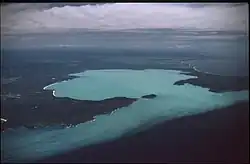
Octopolis and Octlantis are two non-human settlements occupied by gloomy octopuses (Octopus tetricus) in Jervis Bay, on the south coast of New South Wales. The first site, named "Octopolis" by biologists, was found in 2009. Octopolis consists of a bed of shells (mainly scallop shells) in an ellipse shape, 2–3 meters diameter on its longer axis, with a single piece of antropogenic detritus, believed to be scrap metal, within the site. Octopuses build dens by burrowing into the shell bed. The shells appear to provide a much better building material for the octopuses than the fine sediment around the site. Up to 14 octopuses have been seen at Octopolis at a single time. In 2016, a second settlement was found nearby, named "Octlantis," which includes no human-made objects and can house similar numbers of octopuses.[2] Both sites are within Booderee National Park. Some media accounts have described these sites as octopus "cities," but researchers who have worked on the sites view this as a misleading analogy.[3]
See also
- Cephalopod intelligence
- Octopus's Garden, a 1969 song by the Beatles. Ringo Starr wrote the song after learning about how octopuses travel along the sea bed picking up stones and shiny objects with which to build gardens.[4]
References
- ↑ Nield, David (10 June 2018). "Biologists Have Discovered an Underwater Octopus City And They're Calling It Octlantis". Archived from the original on 9 July 2022. Retrieved 9 July 2022.
- ↑ Scheel, David; Chancellor, Stephanie; Hing, Martin; Lawrence, Matthew; Linquist, Stefan; Godfrey-Smith, Peter (2017-07-04). "A second site occupied by Octopus tetricus at high densities, with notes on their ecology and behavior". Marine and Freshwater Behaviour and Physiology. 50 (4): 285–291. Bibcode:2017MFBP...50..285S. doi:10.1080/10236244.2017.1369851. ISSN 1023-6244. S2CID 89738642. Archived from the original on 2023-05-28. Retrieved 2023-05-28.
- ↑ Scheel, David; Godfrey-Smith, Peter; Linquist, Stefan; Chancellor, Stephanie; Hing, Martin; Lawrence, Matthew (2018). "Octopus engineering, intentional and inadvertent". Communicative & Integrative Biology. 11 (1): e1395994. doi:10.1080/19420889.2017.1395994. PMC 5824970. S2CID 28338698.
{{cite journal}}: CS1 maint: multiple names: authors list (link)Communicative & Integrative Biology 11, 2018 – Issue 1. doi:10.1080/19420889.2017.1395994 - ↑ "Abbey Road". The Beatles Interview Database. Retrieved 25 September 2009.
Further reading
- Gallery of the Settlements
- Octopuses More Social Than Thought, 'Octopolis' Denizens Prove, NewsWeek
- Octopolis at the Giant Cuttlefish blog
External links
- Godfrey-Smith, Peter; Scheel, David; Chancellor, Stephanie; Linquist, Stefan; Lawrence, Matthew (1 January 2021). "In the Line of Fire: Debris Throwing by Wild Octopuses". bioRxiv. doi:10.1101/2021.08.18.456805.
- Godfrey-Smith, Peter; Lawrence, Matthew (July 2012). "Long-term high-density occupation of a site by Octopus tetricus and possible site modification due to foraging behavior". Marine and Freshwater Behaviour and Physiology. 45 (4): 1–8. Bibcode:2012MFBP...45....1G. doi:10.1080/10236244.2012.727617. ISSN 1023-6244. S2CID 83893501.